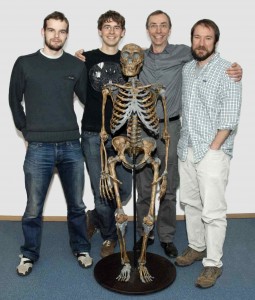New Neanderthals?
by Mark Rose
December 18, 2009
Paleoanthropology and studies of human evolution have long been dependent on discoveries of fossils, with each discovery producing scholarly claims and counterclaims—monkey, ancestor; ancestor, monkey–that eventually advance our knowledge of how we became us. With Neanderthals, for whom we have the most extensive fossil record, the debate in the popular media arena has recently been, did we and they interbreed?
Maybe that sells newspapers but, to me, it is ultimately a sterile debate. Who cares? What seems more important are questions like, what exactly were the differences between us and them (and how, when, where did those come about), what were Neanderthal speech and learning capabilities, and so forth. While bits of fossilized bone may not help answer these questions, DNA analysis might help.
We’re getting closer to understanding the genetic differences between us and the Neanderthals. This past February researchers at the Max Planck Institute for
Evolutionary Anthropology announced that they had analyzed more than 60 Percent of the Neanderthal genome. Okay, it is early days—we haven’t had the entire genome analyzed and it needs to be re-analyzed many times to get a handle on what might be contamination (say, from an eminent archaeologist sneezing on the bone sample in 1905) as opposed to individual variation among Neanderthals.

Neanderthal, center, with Max Planck Neanderthal Genome Research Group
So it was with varying degrees of disbelief among fellow scholars that Harvard Medical School genome researcher George Church said a Neanderthal could be replicated today, if you had a $30 million budget line. He suggested not finding an intact Neanderthal cell, rather a tweaking of a modern human cell’s DNA to match as closely as possible a Neanderthal’s. A chimpanzee could serve as the surrogate mother. Setting aside any of the 10,000 ethical questions that this brings up—almost all of which I would agree with—the question is out there: could we re-create Neanderthals?
Our senior editor Zach Zorich has been interviewing various researchers in this area recently (he’s writing something for our March/April issue about this). I asked him how his interviews were going the other day. To my surprise, he said that there seems to be a consensus that a Neanderthal could be cloned in about a decade. But nobody is advocating this actually be done. Setting aside, once again, any of the 10,000 ethical questions that this brings up, there’s the question of what we would learn. Obviously a “new Neanderthal†would be stripped of any cultural information. Nothing a young Neanderthal would have been taught 50,000 years ago would be retrieved. So, you’d have a human being probably not much different than us. Something or somebody approximating a Neanderthal in a biological sense. You might get insights into physiological based things, like speech, but you’d probably be able to get that just by looking at the genes.
Moreover it sounds a bit like Herodotus’ account of the pharaoh Psammetichus who had two children reared in a speech-free environment so that he could learn—by whatever they spoke spontaneously—what the earliest language was. That or the fate of Ishi, last of the Yahi Indian tribe, who essentially lived as a museum exhibit. My desire for knowledge doesn’t go so far as to replicate these examples.
Comments posted here do not represent the views or policies of the Archaeological Institute of America.






 Heather Pringle is a freelance science journalist who has been writing about archaeology for more than 20 years. She is the author of Master Plan: Himmler's Scholars and the Holocaust and The Mummy Congress: Science, Obsession, and the Everlasting Dead. For more about Heather, see our
Heather Pringle is a freelance science journalist who has been writing about archaeology for more than 20 years. She is the author of Master Plan: Himmler's Scholars and the Holocaust and The Mummy Congress: Science, Obsession, and the Everlasting Dead. For more about Heather, see our 



